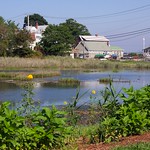Parkhurst Marsh (Marsh Madness Restoration Project)
Overview
This salt marsh, along with many others in the Houghs Neck area of Quincy, is being restored to return proper tidal flows, while improving flood, fire, and mosquito control. Arthur Knowlton, a long-time resident of the Neck, started restoring this marsh many years ago, and in 2000 joined forces with P.J. Foley, a local environmentalist working on the restoration of other marshes in the area. Seventy-five truckloads of rubbish were removed from the marsh. As soon as enough phragmites (an invasive plant that chokes out the native plants) were removed, wildlife returned, including the Glossy Ibis and the North American Osprey, which hasn’t been seen in the area for almost 100 years. With some improvement to the tide gates, minnows now swim in the marsh and eat up the mosquito larvae. Mr. Knowlton has secured funding from Coastal Zone Management for new tide gates.
What’s a salt marsh?
A salt marsh is a low coastal grassland that is covered at least once a month by the rising tide. Salt marshes are found on the edges of estuaries; places where a river flows into the ocean. In the marsh, the water flows very slowly so sediments are dropped from the water and build up a muddy environment where salt adapted plants can grow and small animals can live.
Why are they important?
People can benefit from natural salt marshes in several ways. Salt marshes provide protected nursery areas for juvenile fishes, shellfish, crabs and shrimp. These animals are savored as seafood delights when they grow larger and are caught by fisherman, thereby providing food and a source of income for people. Numerous commercially important fish species spend the early part of their lives in salt marshes. Salt marshes provide a home t for other animals such as birds, small mammals and turtles and serve as a rest stop for migratory waterfowl. Many people visit salt marshes simply to watch birds and enjoy nature's beauty.
The extensive root systems of salt marsh plants enable them to withstand strong winds, waves and flooding from storms, and act as natural buffers against storm damage to upland development. Salt marshes also act as filters. Tidal creeks meander through the marshes transporting valuable nutrients to marsh and estuary inhabitants. Pollutants from upland activities flow through the marsh and may be trapped by marsh vegetation and sediments, reducing the pollutant load entering estuaries. People benefit from the buffering and filtering capabilities of the marsh by having cleaner water. Clean water is good for the environment and helps maintain healthy populations of the fish, shrimp, crabs and oysters.
Location:
Comments
Connections
-
-
- Quincy
-
-
-
-
-
-
-
- LincolnUnited States
- Flagstaff
- EuclidUnited States
- Longboat KeyUnited States
- EnglewoodUnited States
- United States
- PrestonUnited Kingdom
- FifeUnited Kingdom
-
- DubaiUnited Arab Emirates
- United Kingdom
- AkronUnited States
- United States
- United States
- United States
- South Africa
- South Africa
- IthacaUnited States
- PereiraColombia
- Nottingham RoadSouth Africa
- Wisconsin RapidsUnited States
- IthacaUnited States
- Puerto Rico
- CarolineUnited States
-
Multimedia
Arthur Knowlton on Parkhurst Marsh
Impacts
No impacts have been left for this site yet - be the first!





 added by
added by 



